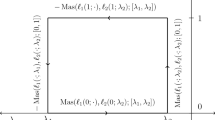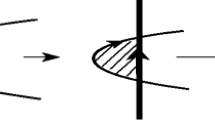Abstract
We calculate the exceptional points of the eigenvalues of several parameter-dependent Hamiltonian operators of mathematical and physical interest. We show that the calculation is greatly facilitated by the application of the discriminant to the secular determinant. In this way, the problem reduces to finding the roots of a polynomial function of just one variable, the parameter in the Hamiltonian operator. As illustrative examples, we consider a particle in a one-dimensional box with a polynomial potential, the periodic Mathieu equation, the Stark effect in a polar rigid rotor and in a polar symmetric top.







Similar content being viewed by others
References
M. Reed, B. Simon, Methods of Modern Mathematical Physics, IV. Analysis of Operators (Academic, New York, 1978)
B. Simon, Int. J. Quantum Chem. 21, 3 (1982)
F.M. Fernández, Introduction to Perturbation Theory in Quantum Mechanics (CRC Press, Boca Raton, 2001)
G. Blanch, D.S. Clemm, Math. Comput. 23, 97 (1969)
C. Hunter, North-Holland Math. Studies 55, 233 (1981)
C. Hunter, B. Guerrieri, Stud. Appl. Math. 64, 113 (1981)
F.M. Fernández, G.A. Arteca, E.A. Castro, J. Math. Phys. 28, 323 (1987)
H. Volkmer, Math. Nachr. 192, 239 (1998)
P.N. Shivakumar, J. Xue, J. Comput. Appl. Math 107, 111 (1999)
C.H. Ziener, M. Rückl, T. Kampf, W.R. Bauer, H.P. Schlemmer, J. Comput. Appl. Math 236, 4513 (2012)
F.M. Fernández, J. Garcia, Appl. Math. Comput. 247, 141 (2014)
F.M. Fernández, E.A. Castro, Phys. Lett. A 107, 215 (1985)
Mesón M, A. M S, Fernández F M, Castro E A, Phys. Lett. A 124, 4 (1987)
J.J. Sylvester, The London, Edinburgh, and Dublin Philosophical Magazine and Journal of Science. Series 4 2, 391 (1851)
H.B. Griffiths, Am. Math. Month. 88, 328 (1981)
S. Basu, R. Pollack, M.-F. Roy, Algorithms in Real Algebraic Geometry (Springer, Berlin, 2003)
V.V. Stepanov, G. Müller, Phys. Rev. E 58, 5720 (1998)
W.D. Heiss, W.-H. Steeb, J. Math. Phys. 32, 3003 (1991)
T.J. Davis, Eur. Phys. J. D 18, 27 (2002)
I. Freund, J. Opt. A 6, S229 (2004)
W.D. Heiss, F.G. Scholtz, H.B. Geyer, J. Phys. A 38, 1843 (2005)
M. Bhattacharya, C. Raman, Phys. Rev. Lett. 97, 140405 (2006)
M. Bhattacharya, Am. J. Phys. 75, 942 (2007)
M. Bhattacharya, C. Raman, Phys. Rev. A. 75, 033405 (2007)
M. Bhattacharya, C. Raman, Phys. Rev. A 75, 033406 (2007)
A.T. Kotvytskiy, S.D. Bronza, Odessa Astron. Pub. 29, 31 (2016)
C.H. Townes, A.L. Schawlow, Microwave Spectroscopy (McGraw-Hill, New York, 1955)
J.H. Shirley, J. Chem. Phys. 38, 2896 (1963)
J.V. Hajnal, G.I. Opat, J. Phys. E 24, 2799 (1991)
Acknowledgements
The research of P.A. was supported by Sistema nacional de Investigadores (México). F.M.F. acknowledges a travel grant from the University of La Plata.
Author information
Authors and Affiliations
Corresponding author
Appendices
Resultant and discriminant
In this section, we summarize those properties of the discriminant of a polynomial that are relevant for present paper. All the expressions shown here are available in the literature mentioned earlier [14,15,16, 26] and also in the web (https://en.wikipedia.org/wiki/Resultant, https://en.wikipedia.org/wiki/Discriminant). The resultant of two polynomials
is given by the determinant
It can be proved that
where \(\xi _{i}\) and \(\mu _{j}\) are the roots of the polynomials f and g , respectively. The discriminant of f(x) is defined as
and in this case, we have
Suppose that the nonlinear equation \(Q(E,\lambda )=0\) gives us the eigenvalues \(E(\lambda )\) of a quantum-mechanical system. If this equation is a polynomial function of E, then the roots of \(F(\lambda )=Disc_{E}(Q(E,\lambda ))\) are the exceptional points \(\lambda _{EP}\) in the complex \(\lambda \) plane where at least two eigenvalues coalesce. We appreciate that the advantage of resorting to the discriminant is that we only have to search for the roots of a nonlinear function of just one variable. In all the examples studied here, the nonlinear equation \( Q(E,\lambda )\) is a polynomial function of both E and \(\lambda \) so that \( F(\lambda )\) is a polynomial function of \(\lambda \) (see “Appendix B,” and the examples). Consequently, the calculation is particularly simple because there are efficient algorithms for finding the roots of polynomials. Besides, most computer-algebra software enable one to obtain analytical expressions for \(F(\lambda )\) because the discriminant is given by a determinant. Thus, the only numerical step of the calculation reduces to finding the roots of the polynomial \(F(\lambda )\).
As an illustrative example, we consider a trivial toy problem that we deem to be quite interesting: the Hamiltonian operator in matrix form
When \(\beta =0\) the three eigenvalues cross at \(\lambda =1\) and the three eigenvectors are degenerate (they are obviously linearly independent). However, when \(\beta \ne 0\) the eigenvalues do not cross for real values of \(\lambda \) and exhibit avoided crossings as shown in Fig. 8 for \(\beta =0.1\).
The characteristic polynomial is
so that
We appreciate that the three eigenvalues coalesce at any of the two EPs \( \lambda _{EP}=1+\sqrt{2}i/10\) and \(\lambda _{EP}^{*}\) that are branch points of order two. The structure of the avoided crossings in this toy model is similar to that of the modified Lipkin model for \(N=3\) [21].
At \(\lambda _{EP}\) (a similar analysis can be carried out at \(\lambda _{EP}^{*}\)) the matrix \({\mathbf {H}}\) has only one eigenvalue \(E\left( \lambda _{EP}\right) =2\) and only one eigenvector
so that \({\mathbf {H}}\) is defective. By means of the Jordan chain
where \({\mathbf {I}}_{3}\) is the \(3\times 3\) identity matrix, we obtain two additional vectors \({\mathbf {v}}_{2}\) and \({\mathbf {v}}_{3}\) and the matrix
that converts \({\mathbf {H}}\) into a Jordan canonical form
In this simple case, we can easily obtain the EPs directly from the eigenvalues but in most nontrivial problems the use of the discriminant leads to far simpler expressions.
Three-term recurrence relations
Suppose that there is an orthonormal basis set \(\left\{ \left| i\right\rangle ,i=0,1,\ldots \right\} \) such that
where \(H_{i,j}=H_{j,i}\). Therefore, if we expand
the Schrödinger equation \(H\psi =E\psi \) becomes a three-term recurrence relation for the coefficients \(c_{j}\):
One commonly obtains approximate energies by means of the truncation condition \(c_{j}=0\), \(j>N\), so that the roots of the characteristic polynomial given by the secular determinant
converge from above toward the actual energies of the physical problem when \( N\rightarrow \infty \). These determinants can be efficiently generated by means of the three-term recurrence relation [3, 28, 29]
with the initial conditions \(D_{-1}=1\), \(D_{j}=0\) for \(j<-1\). Notice that the dimension of the determinant \(D_{N}\) is \(N+1\).
Rights and permissions
About this article
Cite this article
Amore, P., Fernández, F.M. Exceptional points of the eigenvalues of parameter-dependent Hamiltonian operators. Eur. Phys. J. Plus 136, 133 (2021). https://doi.org/10.1140/epjp/s13360-021-01126-3
Received:
Accepted:
Published:
DOI: https://doi.org/10.1140/epjp/s13360-021-01126-3





